Related Research Articles

The 48th Highlanders of Canada is a Canadian Forces Primary Reserve infantry regiment based in Toronto, Ontario, parading out of Moss Park Armoury. The regiment is part of 4th Canadian Division's 32 Canadian Brigade Group.
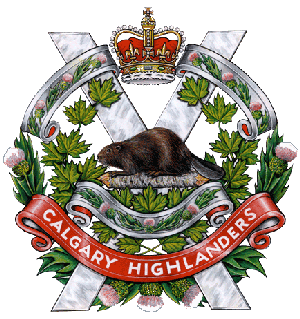
The Calgary Highlanders is a Canadian Army Primary Reserve infantry regiment, headquartered at Mewata Armouries in Calgary, Alberta, Canada. The regiment is a part-time reserve unit, under the command of 41 Canadian Brigade Group, itself part of 3rd Canadian Division, one of four region-based Canadian Army divisions. The regiment is one of only two regiments in the Canadian Forces to wear an honorary distinction on their uniform, commemorating the counterattack at Kitcheners' Wood. On 9 January 2015, the regiment was recognized with the Canadian Forces' Unit Commendation for outstanding contributions to the war in Afghanistan.

The 12e Régiment blindé du Canada is a Canadian Army armoured regiment based in CFB Valcartier, on the outskirts of Quebec City. The regiment has both a Regular Force and a Primary Reserve unit. The 12e Régiment blindé du Canada's abbreviation is 12e RBC.

The Royal Hamilton Light Infantry (RHLI) is a Primary Reserve infantry regiment of the Canadian Army, based at John Weir Foote VC Armoury in Hamilton, Ontario. The RHLI is part of 31 Canadian Brigade Group, which is part of 4th Canadian Division.

The Toronto Scottish Regiment is a Primary Reserve infantry regiment of the Canadian Army. It is part of 4th Canadian Division's 32 Canadian Brigade Group.

The British Columbia Regiment is a Primary Reserve armoured reconnaissance (recce) regiment of the Canadian Army; the regiment is subordinate to 39 Canadian Brigade Group of the 3rd Canadian Division. Established in 1883, it is the oldest military unit in Vancouver, British Columbia. It parades at the Beatty Street Drill Hall at the corner of Dunsmuir and Beatty in downtown Vancouver. The regiment has been variously designated as garrison artillery, rifles, infantry, and armoured, but has been reconnaissance since 1965. It has received 41 battle honours in its history, and has been a unit of the Royal Canadian Armoured Corps since 1942.
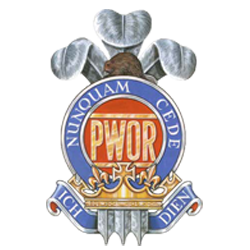
The Princess of Wales' Own Regiment (PWOR) is a Primary Reserve infantry regiment of the Canadian Forces.

The North Saskatchewan Regiment is a Primary Reserve infantry regiment of the Canadian Army, headquartered in Saskatoon, Saskatchewan, with companies in Saskatoon and Prince Albert. Its current commanding officer is Lieutenant-Colonel Dennis Sansom. The N Sask R is part of the 3rd Canadian Division's 38 Canadian Brigade Group.

The Canadian Scottish Regiment is a Primary Reserve infantry regiment of the Canadian Army based on Vancouver Island in British Columbia.
The 205th (Tiger) Battalion, CEF was a unit in the Canadian Expeditionary Force during the First World War. Established in late 1915, it was stationed in Hamilton, Ontario and began recruiting toward the end of February 1916. In late 1916, the unit was redesignated a machine gun battalion, but a few months later, in April 1917, the 205th (Tiger) Battalion was broken up for drafts. One company was transferred to the 164th Battalion, CEF, which was recruiting in nearby Halton County. The unit continued to exist as the 205th Machine Gun Depot and then the 205th Machine Gun School.
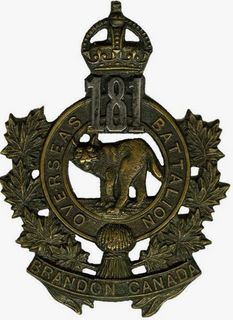
The 181st Battalion (Brandon), CEF was a unit in the Canadian Expeditionary Force during World War I.
The 157th Battalion, CEF was a unit in the Canadian Expeditionary Force during the First World War.
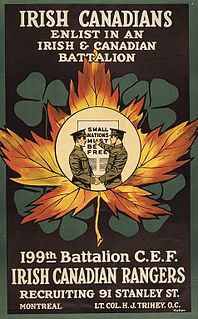
The 199th Battalion, CEF was a unit in the Canadian Expeditionary Force during the First World War.

The 12th Manitoba Dragoons is an armoured regiment of the Canadian Army that is currently on the Supplementary Order of Battle.

The 87th Battalion, CEF was a Household Foot Guards infantry unit in the Canadian Expeditionary Force during the First World War. Based in Montreal, Quebec, the unit was authorized on September 15, 1915, as an exclusively Canadian Grenadier Guards (CGG) formation with Guards uniforms and accoutrements approved by The Governor General of Canada, HRH, Duke of Connaught. Mobilization and recruiting for soldiers began on October 23, 1915.

The Royal Rifles of Canada was a rifle regiment in the Canadian Army and fought alongside The Winnipeg Grenadiers in the Battle of Hong Kong during World War II.

The 10th Battalion, Canadian Expeditionary Force was a unit of the First World War Canadian Expeditionary Force (CEF), specifically in the 1st Canadian Division from 1914 to 1919. The battalion participated in every major Canadian battle of the First World War, and set a record for the most decorations earned by a Canadian unit in a single battle at Hill 70. The unit was known to its contemporaries simply as The Fighting Tenth.
The 12th Battalion, CEF, an infantry battalion of the First World War Canadian Expeditionary Force. It was authorized on 10 August 1914 and embarked for Britain on 30 September 1914, where it was redesignated the 12th Reserve Infantry Battalion, CEF on 29 April 1915, to provide reinforcements for the Canadian Corps in the field. The battalion was reduced during the summer of 1916 and ultimately dissolved. Its residual strength was absorbed on 4 January 1917 into a new 12th Reserve Battalion, upon re-organization of the reserve units of the Canadian Infantry. The battalion was officially disbanded on 30 August 1920.
210th may refer to:
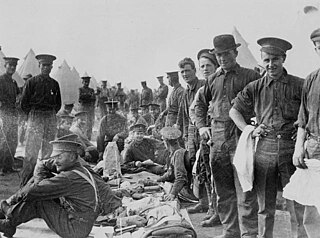
The 11th Battalion, CEF, an infantry battalion of the Canadian Expeditionary Force, was authorized on 10 August 1914 and embarked for Great Britain on 30 September 1914. It was redesignated as the 11th Reserve Infantry Battalion, CEF, on 29 April 1915, to provide reinforcements to the Canadian Corps in the field. On 4 January 1917, its personnel, along with the personnel of the 100th Battalion, CEF, were absorbed by a new 11th Reserve Battalion (Manitoba), CEF. The battalion was disbanded on 12 October 1917.
References
Meek, John F. Over the Top! The Canadian Infantry in the First World War. Orangeville, Ont.: The Author, 1971.